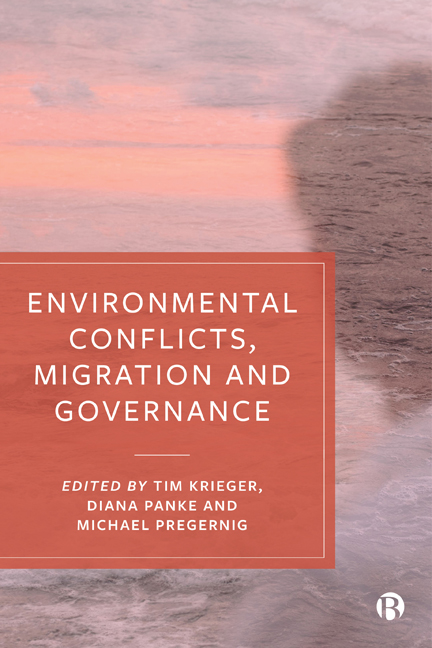Book contents
- Frontmatter
- Contents
- List of Figures and Tables
- List of Acronyms
- Notes on Contributors
- Acknowledgements
- 1 Environmental and Resource-Related Conflicts, Migration and Governance
- 2 Renewable Resource Scarcity, Conflicts and Migration
- 3 Extractive Resources, Conflicts and Migration
- 4 Climate Change, Conflicts and Migration
- 5 The Individual Level: Selection Effects
- 6 The Individual Level: Sorting Effects
- 7 Migration Governance at the State Level: Policy Developments and Effects
- 8 Environmental Migration Governance at the Regional Level
- 9 Migration Governance at the Global Level: Intergovernmental Organizations and Environmental Change-Induced Migration
- 10 The Link between Forced Migration and Conflict
- 11 Conflict-Prone Minerals, Forced Migration and Norm Dynamics in the Kimberley Process and ICGLR
- 12 On the Nexus Between Environmental Conflict, Migration and Governance: Concluding Remarks
- Index
5 - The Individual Level: Selection Effects
- Frontmatter
- Contents
- List of Figures and Tables
- List of Acronyms
- Notes on Contributors
- Acknowledgements
- 1 Environmental and Resource-Related Conflicts, Migration and Governance
- 2 Renewable Resource Scarcity, Conflicts and Migration
- 3 Extractive Resources, Conflicts and Migration
- 4 Climate Change, Conflicts and Migration
- 5 The Individual Level: Selection Effects
- 6 The Individual Level: Sorting Effects
- 7 Migration Governance at the State Level: Policy Developments and Effects
- 8 Environmental Migration Governance at the Regional Level
- 9 Migration Governance at the Global Level: Intergovernmental Organizations and Environmental Change-Induced Migration
- 10 The Link between Forced Migration and Conflict
- 11 Conflict-Prone Minerals, Forced Migration and Norm Dynamics in the Kimberley Process and ICGLR
- 12 On the Nexus Between Environmental Conflict, Migration and Governance: Concluding Remarks
- Index
Summary
Introduction
This chapter considers how environmental change is both a cause and an effect of human migration, with an emphasis on the former. Specifically, this chapter helps explain how environmental migrants are ‘selected’ at the individual and small-group level, but it is attentive to the fact that dislocated populations create conditions in destinations that aggravate existing social and environmental vulnerabilities, and consequently generate conditions for increased levels of human migration. In other words, environmental change and human migration are linked in a feedback loop, where environmental migrants may create conditions that generate more environmental migrants. It is somewhat arbitrary to determine where the causal chain begins; consequently, this chapter diverges from other chapters in categorizing migrants based on the type of environmental change that is the proximate cause of human migration (see, for example, Chapters 2 and 3). This is conceptually useful because the institutional responses to migrations, including the governance of these human migration flows, vary by whether these changes are based on disasters, planned destruction, or gradual degradation of environments.
The crux of determining how environmental change affects human migration involves two interrelated considerations: the type of environmental change and the level of control that migrants have over their own movement (see Figure 5.1). Environmental migrants include those who have a great deal of control over the timing and process of relocation, as well as the choice of destination; other environmental migrants may have very little control over the process of relocation. In general, the more agency, or capacity to intentionally act, that an individual has in everyday life, the more agency he or she will exert over migration decisions, although this will be generally less for unplanned disruptions (‘disasters’) and greater for planned disruptions (‘managed onset’) or slow-onset degradation. Individual agency is determined by intersectional social positions that vary dramatically by local context, but some general patterns exist. Younger, relatively affluent, unencumbered, skilled workers who can draw on individual or group-held resources and social networks typically enjoy higher levels of agency in migration, and even when compelled by sudden, unplanned environmental change, they are often indistinguishable from other types of voluntary migrants. These migrants control more aspects of the relocation process, including when they relocate, how they relocate, and where they go.
- Type
- Chapter
- Information
- Environmental Conflicts, Migration and Governance , pp. 83 - 102Publisher: Bristol University PressPrint publication year: 2020



